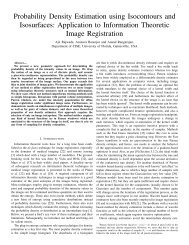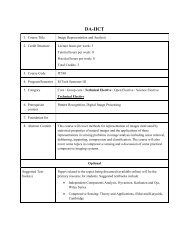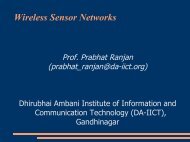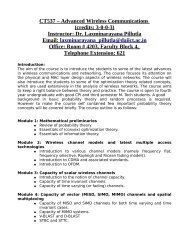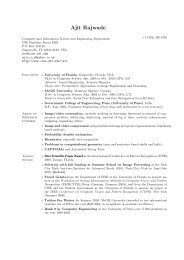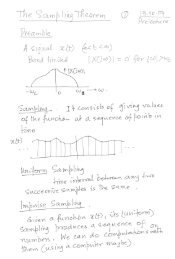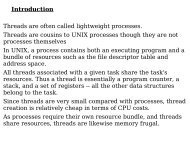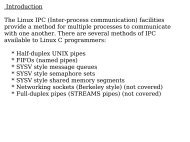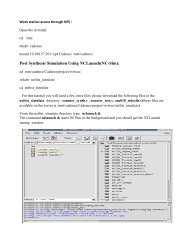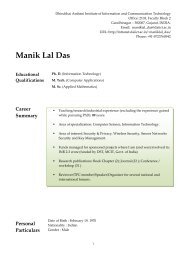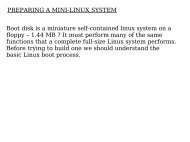iR Remote contRols - DAIICT Intranet - Dhirubhai Ambani Institute of ...
iR Remote contRols - DAIICT Intranet - Dhirubhai Ambani Institute of ...
iR Remote contRols - DAIICT Intranet - Dhirubhai Ambani Institute of ...
You also want an ePaper? Increase the reach of your titles
YUMPU automatically turns print PDFs into web optimized ePapers that Google loves.
InnovatIon<br />
general population,” says pr<strong>of</strong>essor<br />
Ranjan, confident <strong>of</strong> conquering all the<br />
previous limitations.<br />
A complete solution. Taking advantage<br />
<strong>of</strong> MEMS technology-based<br />
accelerometer, CePal senses movements<br />
with high accuracy. “We kept<br />
in mind that cerebral palsy patients do<br />
not have very fine control over movements.<br />
We put logic in the firmware<br />
to detect the tilts,” explains pr<strong>of</strong>essor<br />
Ranjan. Considering each patient’s<br />
movement capability and behavioural<br />
pattern may differ, CePal is also able<br />
to tune parameters to match needs.<br />
“CePal provided flexibility in firmware<br />
to adjust to the needs, making it easy to<br />
be customisable at the user’s end,” says<br />
pr<strong>of</strong>essor Ranjan.<br />
Also, a work in progress would map<br />
the user-generated sound to meaningful<br />
voice outputs. A microphone is attached<br />
to the device that sends the sound input<br />
to the central processing unit via a<br />
wireless link, which is then mapped to<br />
prerecorded voice and corresponding<br />
meaningful response to be fed as the<br />
output to the speaker.<br />
Cost-effective. CePal is much<br />
cheaper than other assistive technology<br />
products in the market. Use <strong>of</strong> the<br />
latest hardware components, including<br />
MEMS-based sensors, has helped to<br />
minimise the number <strong>of</strong> components,<br />
reducing the overall costs. The use<br />
<strong>of</strong> Open Source technology has also<br />
made CePal cost-effective. “We used<br />
Open Source embedded system development<br />
tools and all development is<br />
done on Linux platform. In particular,<br />
we used GNU GCC cross compilers for<br />
firmware development, which helped<br />
to cut costs,” says pr<strong>of</strong>essor Ranjan.<br />
Easy to use. Usability <strong>of</strong> the device<br />
is <strong>of</strong> paramount importance for cerebral<br />
palsy patients and CePal ensures<br />
ease <strong>of</strong> use with its light weight. “We<br />
have used recent developments in<br />
technology to keep the weight low.<br />
The use <strong>of</strong> a microcontroller helped to<br />
reduce the component count. Further,<br />
the complete architecture is designed<br />
on a light-weight PCB to facilitate the<br />
user in using it without any hassle,”<br />
says pr<strong>of</strong>essor Ranjan.<br />
Road ahead<br />
National Trust will test CePal on a<br />
large scale in various parts <strong>of</strong> India. It<br />
has already won the HP Innovate Award<br />
in 2009. Pr<strong>of</strong>essor Ranjan and National<br />
Trust hope to take CePal to the next<br />
level, making it the guiding light for<br />
aged people.<br />
“We are looking at making CePal<br />
<strong>of</strong> great assistance to old people facing<br />
difficulty in the movement <strong>of</strong> limbs<br />
and people suffering from arthritis, paralysis<br />
and other physical impairments<br />
like carpal tunnel syndrome caused by<br />
excessive use <strong>of</strong> keyboard and mouse,”<br />
says pr<strong>of</strong>essor Ranjan. <br />
The author is a business correspondent at EFY<br />
Bengaluru<br />
1 1 8 • April 2 0 1 0 • electronics for you w w w . e f y m A g . c o m



